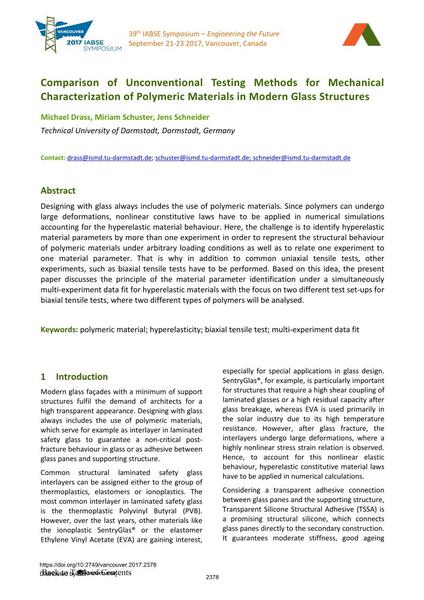Comparison of Unconventional Testing Methods for Mechanical Characterization of Polymeric Materials in Modern Glass Structures

|
|
|||||||||||
Bibliografische Angaben
| Autor(en): |
Michael Drass
(Technical University of Darmstadt, Darmstadt, Germany)
Miriam Schuster (Technical University of Darmstadt, Darmstadt, Germany) Jens Schneider (Technical University of Darmstadt, Darmstadt, Germany) |
||||
|---|---|---|---|---|---|
| Medium: | Tagungsbeitrag | ||||
| Sprache(n): | Englisch | ||||
| Tagung: | IABSE Symposium: Engineering the Future, Vancouver, Canada, 21-23 September 2017 | ||||
| Veröffentlicht in: | IABSE Symposium Vancouver 2017 | ||||
|
|||||
| Seite(n): | 2378-2385 | ||||
| Anzahl der Seiten (im PDF): | 8 | ||||
| Jahr: | 2017 | ||||
| DOI: | 10.2749/vancouver.2017.2378 | ||||
| Abstrakt: |
Designing with glass always includes the use of polymeric materials. Since polymers can undergo large deformations, nonlinear constitutive laws have to be applied in numerical simulations accounting for the hyperelastic material behaviour. Here, the challenge is to identify hyperelastic material parameters by more than one experiment in order to represent the structural behaviour of polymeric materials under arbitrary loading conditions as well as to relate one experiment to one material parameter. That is why in addition to common uniaxial tensile tests, other experiments, such as biaxial tensile tests have to be performed. Based on this idea, the present paper discusses the principle of the material parameter identification under a simultaneously multi-experiment data fit for hyperelastic materials with the focus on two different test set-ups for biaxial tensile tests, where two different types of polymers will be analysed. |
||||
